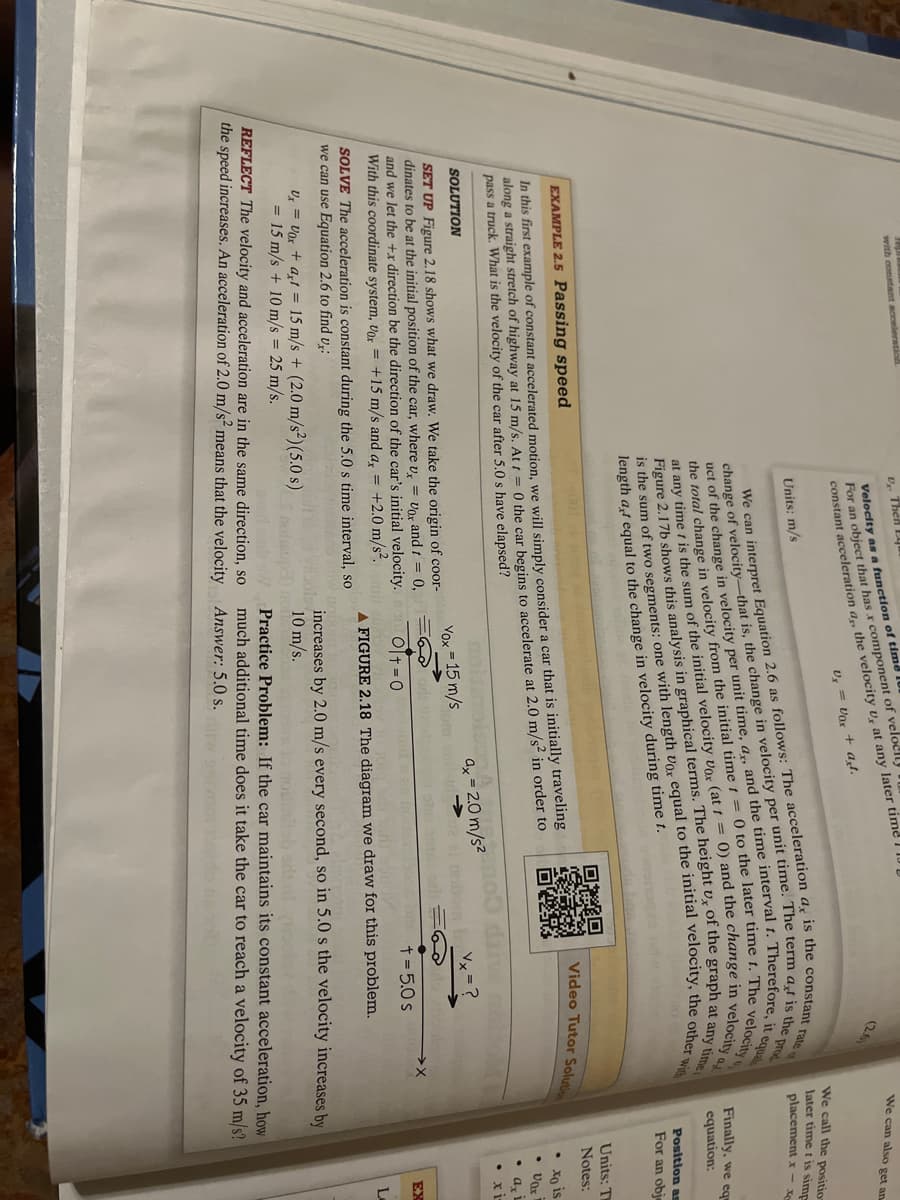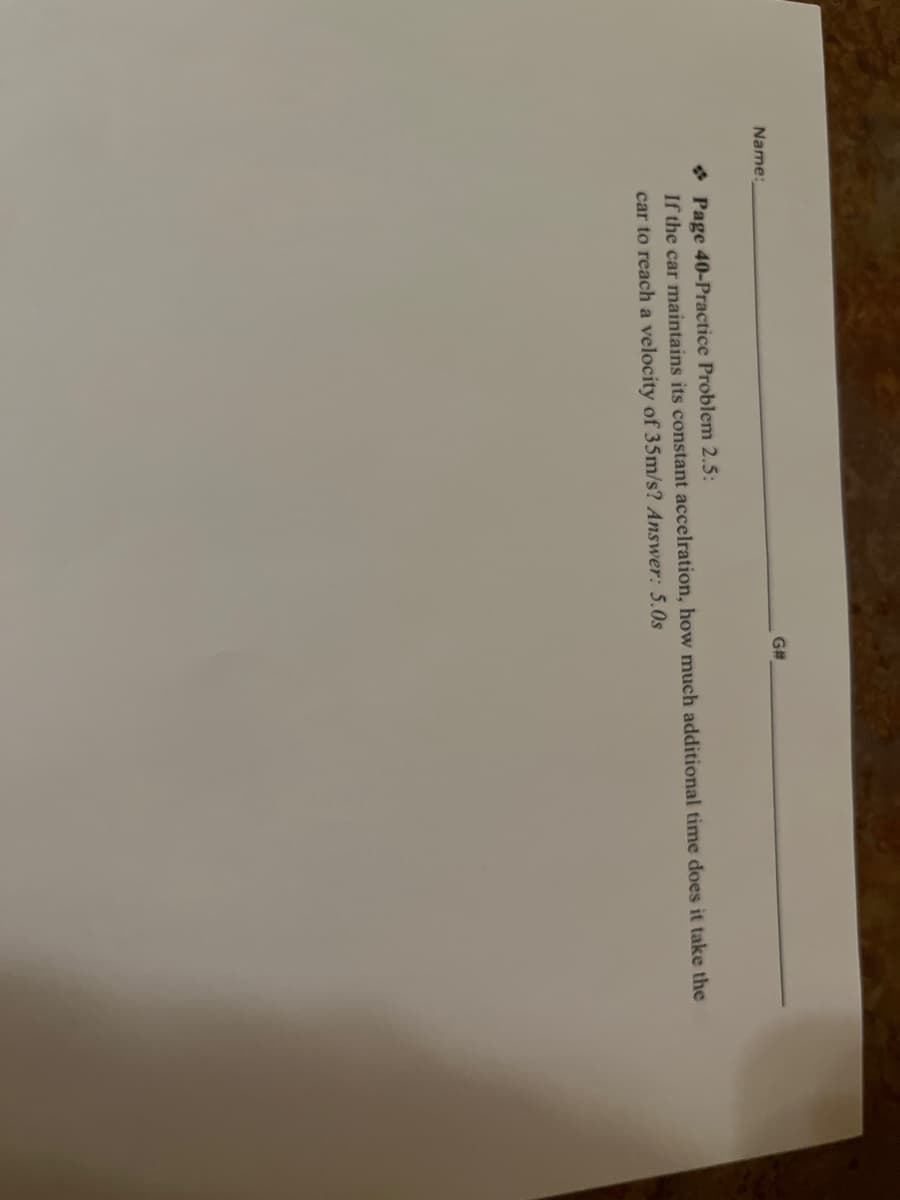is the sum of two length at equal to the change in velocity EXAMPLE 2.5 Passing speed In this first example of constant accelerated motion, we will simply consider a car that is initially traveling along a straight stretch of highway at 15 m/s. At t = 0 the car begins to accelerate at 2.0 m/s² in order to pass a truck. What is the velocity of the car after 5.0 s have elapsed? SOLUTION SET UP Figure 2.18 shows what we draw. We take the origin of coor- dinates to be at the initial position of the car, where U = Vox and t = 0, and we let the +x direction be the direction of the car's initial velocity. With this coordinate system, Vox = +15 m/s and a, = +2.0 m/s². SOLVE The acceleration is constant during the 5.0 s time interval, so we can use Equation 2.6 to find v: Ux= Vox + axt= 15 m/s + (2.0 m/s2) (5.0 s) = 15 m/s + 10 m/s = 25 m/s. REFLECT The velocity and acceleration are in the same direction, so the speed increases. An acceleration of 2.0 m/s² means that the velocity -15 m/s Vox =6 ax=2.0 m/s² OVKO KBorstk Video Tutor Soluti Vx 01 += 0 t=5.0 s A FIGURE 2.18 The diagram we draw for this problem. increases by 2.0 m/s every second, so in 5.0 s the velocity increases by 10 m/s. Practice Problem: If the car maintains its constant acceleration, how much additional time does it take the car to reach a velocity of 35 m/s? Answer: 5.0 s. Units: Notes Xo V a
is the sum of two length at equal to the change in velocity EXAMPLE 2.5 Passing speed In this first example of constant accelerated motion, we will simply consider a car that is initially traveling along a straight stretch of highway at 15 m/s. At t = 0 the car begins to accelerate at 2.0 m/s² in order to pass a truck. What is the velocity of the car after 5.0 s have elapsed? SOLUTION SET UP Figure 2.18 shows what we draw. We take the origin of coor- dinates to be at the initial position of the car, where U = Vox and t = 0, and we let the +x direction be the direction of the car's initial velocity. With this coordinate system, Vox = +15 m/s and a, = +2.0 m/s². SOLVE The acceleration is constant during the 5.0 s time interval, so we can use Equation 2.6 to find v: Ux= Vox + axt= 15 m/s + (2.0 m/s2) (5.0 s) = 15 m/s + 10 m/s = 25 m/s. REFLECT The velocity and acceleration are in the same direction, so the speed increases. An acceleration of 2.0 m/s² means that the velocity -15 m/s Vox =6 ax=2.0 m/s² OVKO KBorstk Video Tutor Soluti Vx 01 += 0 t=5.0 s A FIGURE 2.18 The diagram we draw for this problem. increases by 2.0 m/s every second, so in 5.0 s the velocity increases by 10 m/s. Practice Problem: If the car maintains its constant acceleration, how much additional time does it take the car to reach a velocity of 35 m/s? Answer: 5.0 s. Units: Notes Xo V a
College Physics
1st Edition
ISBN:9781938168000
Author:Paul Peter Urone, Roger Hinrichs
Publisher:Paul Peter Urone, Roger Hinrichs
Chapter2: Kinematics
Section: Chapter Questions
Problem 20PE: An Olympic-class sprinter starts a race with an acceleration of 4.50 m/s2. (a) What is her speed...
Related questions
Question
The second photo had background info to help solve the practice problem.

Transcribed Image Text:Pap
with constant acceleration
v Then E
Velocity as a function of time
For an object that has x component of velocil
constant acceleration a,, the velocity U, at any later time
Ux= Vor + at.
Units: m/s
uct of the change in velocity per unit time, ar, and the time interval t. Therefore, it equal
change of velocity-that is, the change in velocity per unit time. The term at is the prod
We can interpret Equation 2.6 as follows: The acceleration a, is the constant rate
at any time is the sum of the initial velocity Vox (at t= 0) and the change in velocity a
the total change in velocity from the initial time t= 0 to the later time t. The velocity
Figure 2.17b shows this analysis in graphical terms. The height u, of the graph at any time
is the sum of two segments: one with length vox equal to the initial velocity, the other with
length at equal to the change in velocity during time t.
EXAMPLE 2.5 Passing speed
In this first example of constant accelerated motion, we will simply consider a car that is initially traveling
along a straight stretch of highway at 15 m/s. At t=0 the car begins to accelerate at 2.0 m/s² in order to
pass a truck. What is the velocity of the car after 5.0 s have elapsed?
SOLUTION
SET UP Figure 2.18 shows what we draw. We take the origin of coor-
dinates to be at the initial position of the car, where u = Vox and t = 0,
and we let the +x direction be the direction of the car's initial velocity.
With this coordinate system, Vox = +15 m/s and a, = +2.0 m/s².
SOLVE The acceleration is constant during the 5.0 s time interval, so
we can use Equation 2.6 to find vx:
Ux = Vox + axt= 15 m/s + (2.0 m/s²) (5.0 s)
= 15 m/s + 10 m/s = 25 m/s.
REFLECT The velocity and acceleration are in the same direction, so
the speed increases. An acceleration of 2.0 m/s² means that the velocity
Yox = 15 m/s
ano
ax=2.0 m/s²
ote onts: ori
We can also get an
We call the position
later time t is simp
placement x-xe
Video Tutor Solution
Finally, we equ
equation:
Position as
For an obje
Units: Th
Notes:
Ot=0
t = 5.0 s
16
A FIGURE 2.18 The diagram we draw for this problem.
increases by 2.0 m/s every second, in 5.0 s the velocity increases by
10 m/s.
Hab oft of
Practice Problem: If the car maintains its constant acceleration, how
much additional time does it take the car to reach a velocity of 35 m/s?
Answer: 5.0 s.
• xo is
• Vax
• ax
xi
L

Transcribed Image Text:Name:
G#
Page 40-Practice Problem 2.5:
If the car maintains its constant accelration, how much additional time does it take the
car to reach a velocity of 35m/s? Answer: 5.0s
Expert Solution
This question has been solved!
Explore an expertly crafted, step-by-step solution for a thorough understanding of key concepts.
This is a popular solution!
Trending now
This is a popular solution!
Step by step
Solved in 2 steps with 2 images

Knowledge Booster
Learn more about
Need a deep-dive on the concept behind this application? Look no further. Learn more about this topic, physics and related others by exploring similar questions and additional content below.Recommended textbooks for you

College Physics
Physics
ISBN:
9781938168000
Author:
Paul Peter Urone, Roger Hinrichs
Publisher:
OpenStax College

College Physics
Physics
ISBN:
9781305952300
Author:
Raymond A. Serway, Chris Vuille
Publisher:
Cengage Learning

College Physics
Physics
ISBN:
9781938168000
Author:
Paul Peter Urone, Roger Hinrichs
Publisher:
OpenStax College

College Physics
Physics
ISBN:
9781305952300
Author:
Raymond A. Serway, Chris Vuille
Publisher:
Cengage Learning